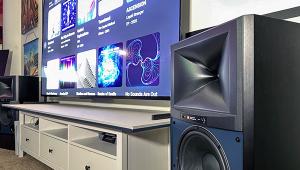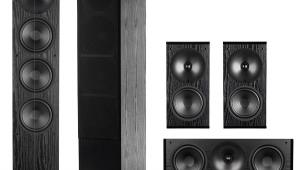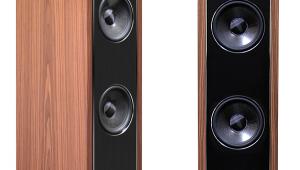GoldenEar T66 Tower Speaker Review: Performance Evolved
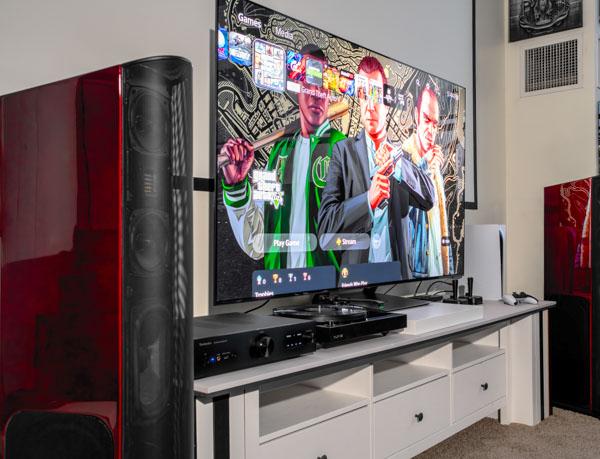
AT A GLANCE
Plus
Exquisite detail rendering
Cohesive soundstage projection
Deep bass extension
Elegant aesthetic design
Minus
Pricey investment
Grille not removable
Requires power cord and speaker cable connection
THE VERDICT
The T66 offers audiophile-grade soundstage and aesthetics. With exceptional detail, powerful bass, and sleek design, these GoldenEar speakers are an outstanding investment in high fidelity.
GoldenEar’s new T66 tower speaker offers audiophiles and home theater enthusiasts high performance in a slender and stylish design. It is a speaker that takes what is already great about the brand and elevates it to a higher level of fit and finish.
The curious thing about these towers is that I feel like I’ve come full circle in an audiophile journey. It was 34 years ago that I put together my first high-end audio system. My speakers then were a pair of Image Concept 200s from API (Audio Products International), a now-defunct group from Canada that also included the Mirage and Energy brands.
My personal proclivities drew me to the Concept 200s because it was a D’Appolito array focused on a high-performance tweeter that was situated in a large, low-tuned ported enclosure. But I wanted even more than what they offered, so I placed each speaker on top of a Bowers & Wilkins AcoustiTune passive subwoofer. I then connected each “stack” to its own Sony TA-N77ES amplifier operating in monoblock mode. The result? 500 Wpc, extension into the 20 Hz range, and exceptional imaging. It’s a combination I have sought in my speakers ever since.
Interestingly, 1990 is the same year that Definitive Technology was founded, and Definitive Technology is well known for putting active subs in tower speakers. It is hardly a coincidence that Definitive Technology was co-founded by Sandy Gross, who previously co-founded Polk. He also founded GoldenEar, where, since its inception, the focus has been on speakers that leverage a D’Appolito MTM (midrange, tweeter, midrange) array featuring an AMT (air motion transformer) tweeter. It’s a combination that offers highly detailed, cohesive sound. The T66 speaker renders exquisite levels of detail in the mids and highs but also plays clean, deep, tangible bass into the 20 Hz range.
So here I am, with the latest evolution of this concept, of a D’Appolito MTM driver array perched atop a subwoofer and wrapped up in a slender tower speaker form factor, one that takes up no more space than the speaker itself and operates as a single system.
Features and Specifications
The T66 is the first model in the new T series and features AudioQuest internal wiring. It follows the classic GoldenEar MTM design, which places an AMT tweeter between a pair of mid/bass drivers in a D'Appolito array, with felt surrounding the tweeter. Still, it also incorporates a powered subwoofer module in the cabinet.
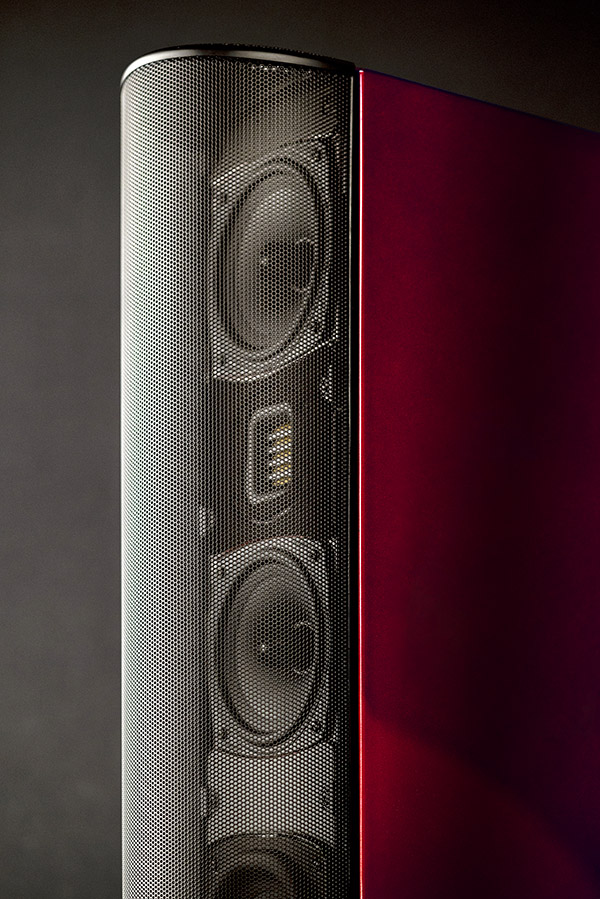
The active subwoofer feature allows listeners to tune bass output to the room (thus compensating for room gain) and to tweak bass response to taste. Despite being such a narrow speaker, it also makes a frequency response of 29 Hz-25 kHz possible. And that narrowness doesn’t just look cool; it also minimizes the surface area of the front baffle.
To maintain that narrow profile, the powered subwoofer section’s drivers are front-firing and have a “racetrack” design: ovals with straight sides. This approach allows the speaker to squeeze more driver surface area into the narrow front baffle profile.
Thanks to their opposing alignment, side-firing passive radiators exhibit force-canceling qualities while enhancing the bass output in a manner similar to a ported cabinet but without any chance of audible turbulence.
One prominent feature of this speaker has nothing to do with specifications. It’s industrial design. Gone is the GoldenEar “sock,” which in legacy Triton models is a single black cloth that covers the entire speaker. This all-black monolith loom is highly appropriate for dedicated home theater. Still, the T66 elaborates on the aesthetic introduced with the flagship Triton Reference and Triton One.R, with glossy paint and a full-length metal grille.

GoldenEar’s latest ups the ante even further design-wise and is far more appealing in appearance when seen in a living room environment than any GoldenEar speaker before it.
The T66 speakers have an exquisitely glossy paint job. The review units came in Santa Barbara Red, which costs $150 more per speaker than the gloss black. The grilles are partly see-through black metal mesh, allowing you to glimpse the drivers: the D'Appolito array layout and the felt surrounding the tweeter.
Setup
I tested the T66 towers in two different configurations. One was part of a 4.1 system, with a pair of GoldenEar Triton 7 towers serving as surrounds. These speakers were connected to electronics consisting of a Marantz AV10 pre/pro and AMP 10 amplifier, a potent combo providing processing and power.
The other configuration is a pure two-channel 2.0 system that’s as minimalist yet high-fidelity as possible. Here, a Technics SU-GX70 integrated networked amplifier served as the source and provided the power.
AudioQuest sent some of its premium cabling with the speakers. I’m not a judge of the impact cables have on sound, but the NRG-Z3 AC power cables and Rocket 33 speaker cables are an aesthetic and build quality match to the speakers and performed their respective jobs flawlessly.

I used the AudioQuest speaker cable with the Technics setup. They are designed to bi-wire the speakers, with a single pair of leads going to the amp and dual leads on the speaker side. I used 14-gauge, in-wall-rated speaker cables for the Marantz system located on the side of the room.
The Marantz AMP 10 offers integrated bi-amping capability and 400W output into 4 ohms. GoldenEar recommends up to 500W of amplification, so based on specs it is a good match.
The biggest difference between the two-channel and surround-sound approaches is that with the Marantz, the focus is home theater versus music and on integrating a dedicated sub. I used room correction with EQ, namely Audyssey MultEQ XT32, along with the MultEQ-X PC software. Playing along with the speakers is an unreleased prototype dual-opposed 12” subwoofer.
When using the Technics, I treated the system as a purely two-channel, 2.0 setup, albeit one that has HDMI ARC connectivity, so TV, movies, and games are still in the mix.
Two Channels
Let’s talk about the Technics two-channel system first. If you go this route, there are multiple benefits to each T66 having an adjustable active subwoofer. First, add 1,000W RMS amplification to the mix. Last I checked, there’s significant value in that alone.
Granted, adjusting the bass levels to match the room is obvious. But less obvious is that by taking away the need to have the outboard amplifier power the deepest bass that the speaker can reproduce, it leaves more power for the rest of the audio spectrum. The result is the modest output of the Technics—60Wpc into 4 ohms—is more than enough to turn high-volume level listening sessions into visceral experiences. You don’t run out of steam like you would if the amp had to do it all.
Technics does have its own speaker-optimizing capability that matches the amp to the impedance of the speakers. But that’s not room correction, and for purists, tuning the bass with the gain controls on the speakers yields an excellent result while introducing no additional processing or EQ to the signal chain. Once you find that balance for the bass—which does not require moving the speakers, unlike with purely passive designs—the overall sound achieved with a pure 2.0 stereo leaves nothing on the table. For the same money spent, I’d easily opt for this speaker pair over a lesser surround-sound system for the same money spent.
This system, in its two-channel purity and impressive audio fidelity, truly reminded me of what got me hooked on hi-fi to begin with, and it’s not how many speakers you can stuff in a dark room. It’s how amazing a great pair of speakers can sound in your living room that I care about most.
While I wish I had a Technics to play with, my record collection is way too small to justify that. What I do have is a Fluance RT81P, an entry-level, affordable record spinner that comes with an Audio Technica VM95E cartridge, a classic bang-for-the-buck option. It’s not the focus of the review.
Most of my music streams in CD quality (or higher) through Roon and a Tidal subscription. With the Technics I enjoyed settling in for deep listening sessions where I played an entire album and listened from the sweet spot, taking in the totality of the mix on any given track. It reminded me of what inspired me to buy that original hi-fi system 34 years ago.
Surround Sound
With the Marantz, the goal is to use room correction to create a cohesive surround-sound envelope (Atmos notwithstanding). I do have Atmos speakers hung, although they are not GoldenEar so I did not include them in the evaluation, although I did use them casually. As usual with Atmos, your mileage may vary depending on the mix.
A 4.1 system (with a phantom center) is the minimum channel count you’d want for proper cinematic surround-sound audio immersion. What I will say is the Triton 7 towers used as surrounds paired extremely well with the T66 towers—as you might expect given their shared lineage. The result is not sound that gives the impression of bouncing between four speakers. Instead, it sounds like total seamless immersion within a 360-degree audio bubble. I did not even miss Atmos height effects because the illusion of immersion is so seamless. The credit goes to how all the speakers work together to render a holographic soundstage and imaging. In a living room setting, on my IKEA sofa, four GoldenEar speakers with T66 towers up front are all you need for total audio immersion.

After running Audyssey via MultEQ-X I looked at the results. I can clearly see it meets its 29 Hz bass specification. Extension down to the mid-20 Hz region is consistently visible in all the measurement locations. But what’s really impressive is the linearity of the rest of the frequency range. This is not the typical roller coaster graph I often see. It is refined, a smooth slight downward slope that’s absolutely textbook what you want to see in a well-tuned response. There’s truly no reason to apply EQ or correction above the Schroeder/transition frequency when the response is already this good in-room.
Music
Music makes the strongest argument for taking one’s entire budget for speakers and spending it on just a single pair. The truth is that good stereo imaging is like having an almost infinite number of speakers, it can create sound fields that fully envelope you, and appear to expand beyond the confines of the listening space. And then there’s the feeling of a tight and cohesive two-channel musical presentation playing through powerful speakers that don’t succumb to dynamic compression. These are costly qualities but the reward is realism, the sense of the speakers disappearing and of the holographic soundstage giving each sound size, shape, and texture.
These qualities led me to listen to a “greatest hits’’ compilation of music via Tidal and Roon, using the Technics. Music that in my humble opinion sounds awesome on excellent stereo systems, starting with Love and Rockets and their excellent sounding, critically acclaimed—but poorly received by fans—stab at ambient techno, Hot Trip to Heaven. I find it sounds amazing to this day, especially so with the T66 towers teasing out the most tender details typically hidden deep within the recesses of the mix.
While it is definitely not for everyone, Skinny Puppy’s Last Rights is one hell of an industrial album. The sonic textures on display are an unparalleled journey into beauty and chaos. It is decidedly not a commercial recording, so you get the impact of the high dynamic range (minimal dynamic compression) that’s missing from modern recordings. Some tracks are quite beautiful, blending distorted guitar and synth pads, drums, and vocals in a potent swirl of angst and anger like “Killing Game” or outright epic instrumentalism like the psychedelic “Riverz End” where I was mesmerized by the drumming.
Emboldened by how well the GoldenEars handle music, I queued up the remastered version of “Further Back and Faster” by Coil from the album Love’s Secret Domain. I don’t know how a track can still sound fresh after over 30 years and hundreds of listens but this one does it! The build-up teasing you… stretching out the anticipation and then that drop… boom, the Didgeridoo starts playing, the beat kicks in, the sounds start flying around the room, and I remember why two-channel listening is so frikkin’ cool. With the best speakers, a great track will blow your mind in no time flat.
But I also know that Snoop Dogg’s album, the funk-flavored Bush, sounded great, and if Fluance is the weak link here, at least it did not break the chain. Bush is a bass heavy but sparkling clean production by Pharrel WIlliams, and even has a Stevie Wonder cameo on the first track, “California Roll.” It came through smooth and clear.
When I say there’s such a thing as good rap music and am asked for an example, I often mention The Roots and quickly find agreement. The Roots are in fact a band, and their recordings, while clearly hip-hop, are also recordings of real instruments played by real musicians, with excellent production qualities. This is true for Rising Down, the eighth studio album by the band (produced by Questlove), which I listened to on vinyl through the Fluance. I found myself marveling at the fidelity achieved by such an affordable record player. Drums with feelable impact, and crystal clear “in the room with you” raps from all the guest vocalists.
Another rap group I love that played its own instruments is the Beastie Boys, and I’d be remiss were I to miss a chance to play Hello Nasty on vinyl. It’s loud and crunchy and shows that the T66 towers will not enforce some sort of artificial “politeness” to the proceedings. If brash is what’s called for, brash is what you get.
Movies and Video Games
While it’s sort of unsurprising that the charms of two-channel listening remain strong, I am surprised to find that I have become a contrarian when it comes to expansive multichannel surround sound. And it’s certainly not for lack of exposure to highly competent systems I’ve heard at various demos or the rather extreme Atmos-capable rigs I've had in my own home.
It’s just that every time the equation turns to “spend the budget on more channels versus fewer, better channels” what’s achievable by focusing a budget on the most important channels in the system keeps slapping me in the face and saying “wake up!" The point of diminishing returns for ever-higher channel counts comes on a lot faster than it does when upgrading speakers in a fixed, modest number of channels. And the savings don’t just come from buying fewer speakers, it costs a lot more to buy an AVR or processor that does 11.4.4 channels than a unit with a more modest channel count. But, in my view, that’s more money that can instead go into great-sounding speakers, like the T66 towers.
I find a phantom center preferable to a dedicated center channel for a TV in a living room setup. The reason for that is the center channel always has to go beneath the TV or maybe above the TV. Neither of these locations is ideal and they visually detract from the aesthetic of two stylish tower speakers. Not that I am in any way opposed to center channel speakers, but if the focus is on home theater, by all means, use one. Plus if you go with a two-channel solution like the Technics, there’s no center channel option to begin with.
With a phantom center and the T66 towers imaging so well, dialogue appears to come from the middle of the screen, right where it’s supposed to. The catch is that not all speakers can pull off this trick. In fact, I’ve found it to be a relatively rare quality, but one I seek out and note when it does happen.
I watched several movies during the review, including Napoleon, Oppenheimer, American Fiction, half of The Marvels, and a rewatch of Aliens, which I know by heart. What I noticed, is what I did not notice. When watching the movies, I totally forgot what sort of system I was listening to. Each and every time! With just 4.1 channels, the sound was seamless and correct to the point where with the lights out and a movie playing, everything was “just right” and you don’t question it. And that, by the way, is the elusive “suspension of disbelief” and “immersion” you read about all the time. It’s as simple as that!
Overall Performance
Given the GoldenEar design heritage and AudioQuest explicitly building upon an already successful lineage, it is no surprise that the T66 towers perform at a very high level.

Perceptually, they offer incredible imaging and soundstaging. Objectively, the measurements exhibit excellent linearity and extension in the in-room response. In its marketing, GoldenEar emphasizes the excellent soundstage and imaging capabilities of its speakers. This is not mere marketing spin. It was clearly observable every second I listen to this pair of speakers in my living room. It’s a quality that has defined my experience with the brand, ever since I first heard a pair of Triton towers over a decade ago. Bottom line, I like the sort of speaker that GoldenEar is known for.
I find its most impressive quality is the stability of the soundstage. You get a proper floating stereo image, even if you’re not seated in the exact sweet spot. It does not collapse when you are off-axis, and its ability to project a holographic image over the seating area of a typical sofa makes staying with a phantom center channel an appealing option.
The big surprise is how irrelevant I found room correction and multichannel surround. When it comes to performance, the simple 2.0 system with the Technics in charge has just about everything I ever look for in an audio system.
Conclusion
These new GoldenEar T66 speakers are a major upgrade to the offerings of an already great brand. Aesthetically and performance-wise, they significantly raise the performance and aesthetics bar. Although seemingly premium priced, with the subwoofer integration, they deliver a lot of value for a speaker at their price point.
The key is that thanks to GoldenEar’s extensive lineup of center channel, surround speaker, and subwoofer options, you can start with a pair of T66 towers and build out as elaborate a surround-sound system as you’d like. Or instead, thanks to their quality, you can keep it simple and get exceptional performance out of a purely two-channel system. One that costs four figures, but sounds like it costs five figures.
In other words, these are not merely excellent audiophile speakers. They are not simply awesome home theater speakers. To my ears and to my eyes, GoldenEar’s T66 towers are nothing less than an audiophile masterpiece.
Specs
One Reference high-velocity folded ribbon AMT Tweeter
Two 4.5" mid/bass drivers
Two 5" x 9" Long-throw subwoofers
Two 8" x 12" passive radiators
Sensitivity: 91 dB 1W/1M @ 4Ω
Frequency Response: 29 Hz–25 kHz typical (-6 dB on axis @ 29 Hz, anechoic bass response)
Nominal Impedance: 4Ω
Recommended Amplification: 20 - 500 Wpc
Built-In Subwoofer Power Amplification: 1,000W peak/500W RMS, DSP-Controlled
Dimensions
Tower: 7.5" W x 14.75" D x 48.8" H (with base, no spikes)
Base: 11.8" W x 17" D
Weight: 60 lbs.





